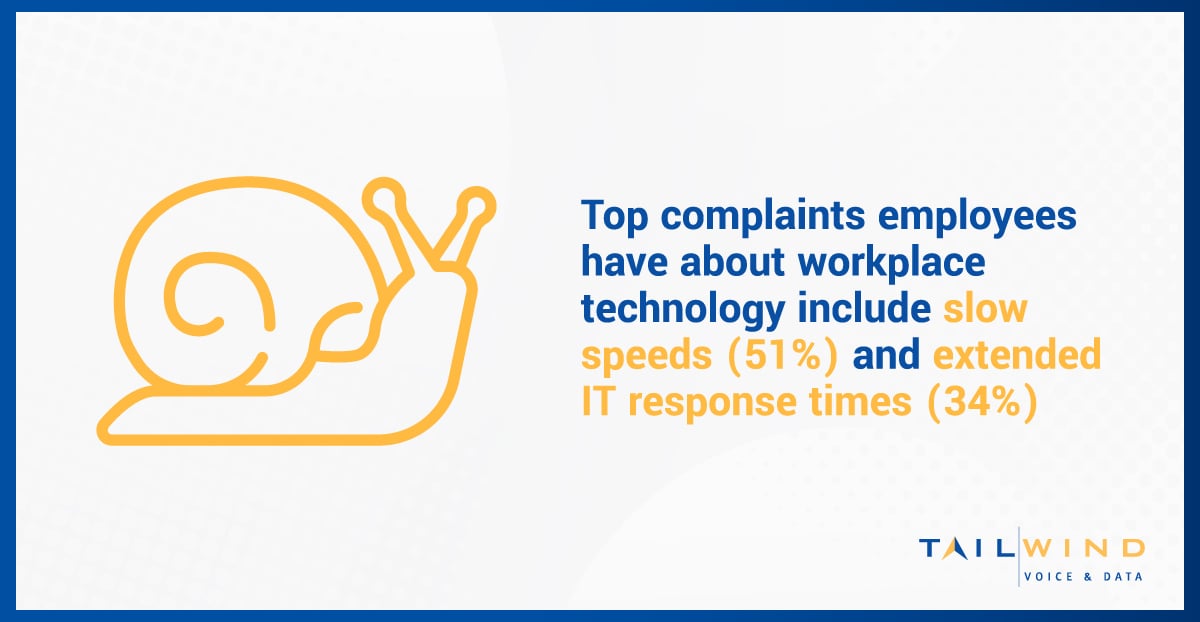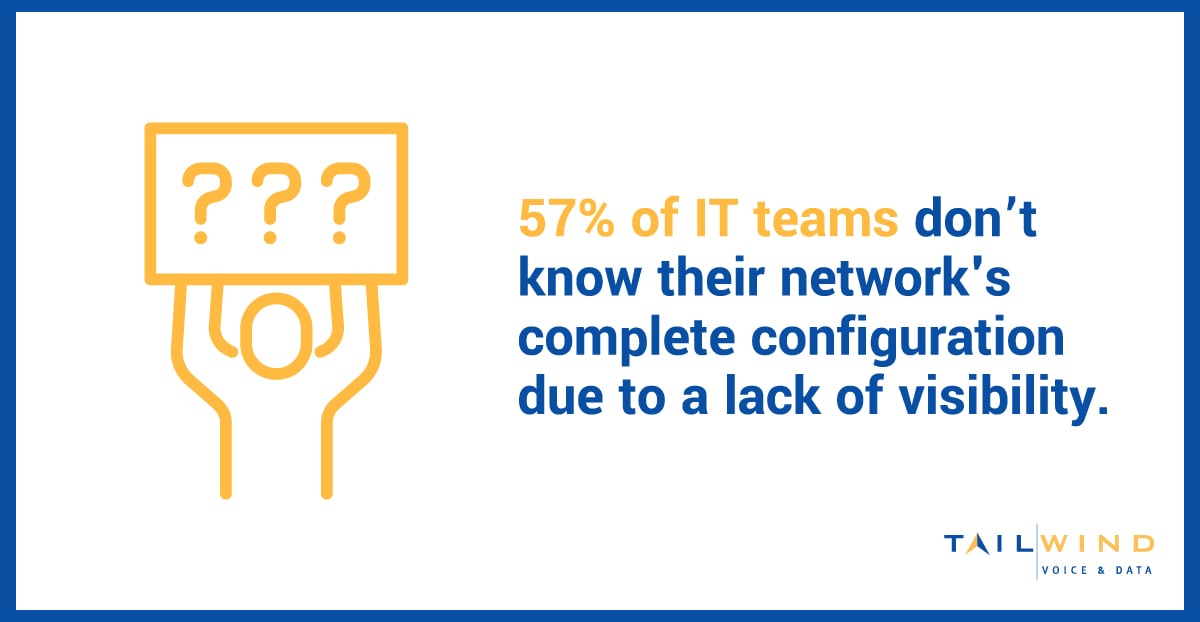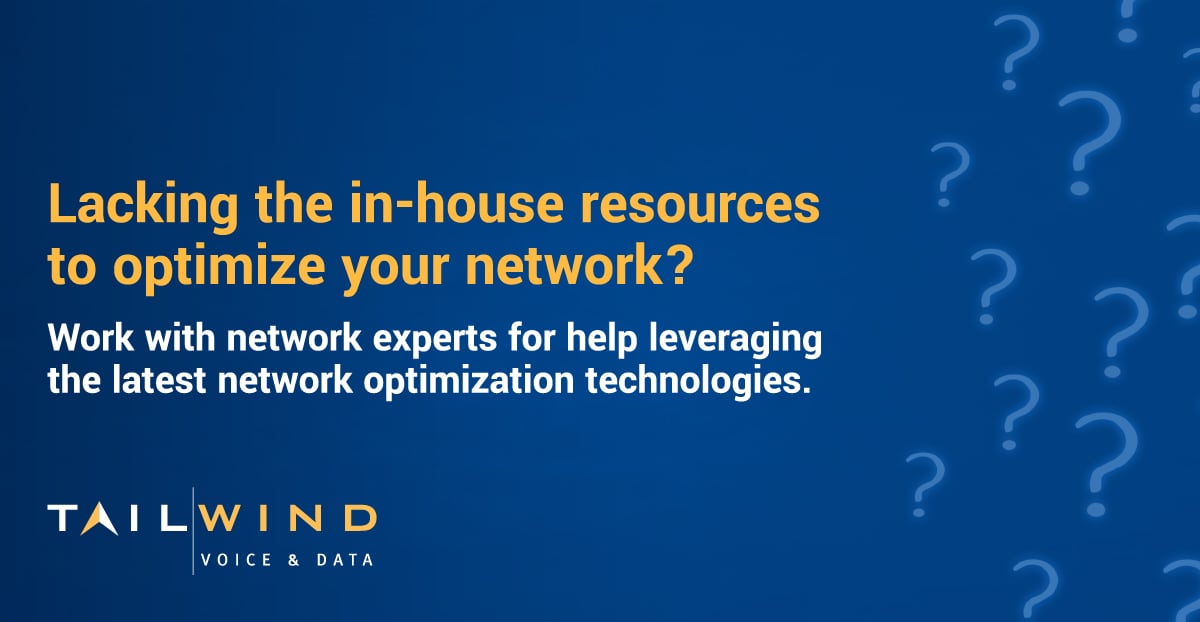An optimized network can mean the difference between a smooth workflow and a sluggish experience that hinders productivity and business growth. A staggering 91% of employees say they’re frustrated with their workplace’s inadequate technology, with slow speeds (51%) and extended IT response times (34%) coming in as the top complaints.1
As demand for seamless connectivity, responsive cloud-based applications, and real-time collaboration rises, optimizing your business network is more important than ever. Read on to learn more about the importance of network optimization and how to improve network performance, security, and reliability.
What Is Network Optimization?
Network optimization is the process of continuously monitoring, analyzing, and improving the performance of a business’s network infrastructure. It involves identifying and eliminating bottlenecks, optimizing bandwidth allocation, and implementing various techniques to ensure the network operates at peak efficiency.
Businesses often overlook the importance of network optimization, assuming that their existing network is sufficient. Unfortunately, ignoring optimization can lead to decreased productivity, security vulnerabilities, and a poor user experience as network demands increase with your growing organization.
What Is the Goal of Network Optimization?
The primary goals of network optimization are:
- Improved Performance - Optimizing your network can significantly enhance its speed, reliability, and overall performance, leading to increased productivity and a better experience for employees and customers alike.
- Stronger Security - An optimized network reduces vulnerabilities and minimizes the risk of cyber threats, data breaches, and other security incidents.
- Cost Savings - By optimizing your network performance, you can maximize the efficiency of your existing infrastructure and potentially reduce the need for costly hardware upgrades or added bandwidth.

What Metrics Impact Network Performance?
Measuring key network performance metrics can help you identify issues and set the baseline for your network optimization KPIs. Here are the metrics to monitor when optimizing your enterprise network:
Latency
Latency is the time it takes for a data packet to travel from source to network destination. High latency causes delays, lag, and frustration for users, particularly in real-time applications like video conferencing.
Bandwidth Utilization
Bandwidth is the amount of data that can be transmitted over your network at any given time. Insufficient bandwidth can lead to slow data transfers, buffering, and poor application performance.
Jitter
Jitter refers to the amount of variation in latency over time. High jitter can cause performance issues with real-time applications, such as choppy audio or video quality during video calls or online meetings.
Availability
Availability measures how often network hardware and software function properly without downtime. While achieving 100% availability is unlikely for complex networks, striving for "five nines" (99.999%) availability is crucial for optimal network performance.
Packet Loss
Packet loss occurs when data packets fail to reach their intended destination. Even a small amount of packet loss can impact network performance and the user experience.
Network Throughput
Throughput is the rate that messages are successfully delivered over a network. Factors like latency, congestion, and packet loss can decrease the network throughput rate, resulting in poor application performance.
What Are the Benefits of Network Performance Optimization?
When managed effectively, network optimization helps businesses build more effective, efficient networks and enjoy advantages such as:
Enhanced User Experience
A well-optimized network provides a seamless and responsive experience for your employees and customers, whether they’re accessing cloud-based applications, collaborating on projects, or streaming multimedia content. With optimized latency, jitter, and bandwidth allocation, users can enjoy lag-free interactions with critical applications and services.
Improved Security Posture
Cyber security resilience is a top priority for 96% of business leaders.2 Network optimization can help security teams mitigate potential security threats faster, protecting your organization's critical data and assets from threats like data breaches, malware, and other cyber attacks. Network monitoring and analysis enable your staff to detect vulnerabilities, suspicious traffic patterns, and potential entry points for cyber threats, ultimately strengthening your security posture.

Increased Productivity
Eliminating network bottlenecks and improving performance reduces downtime and frustrations, enabling your teams to work more efficiently. Employees can access the network resources and applications they need without facing delays or interruptions, contributing to better job satisfaction and morale in addition to productivity gains.
Cost Efficiency
By maximizing the efficiency of your existing infrastructure, you can reduce operational costs and achieve a better return on investment. Effective network performance optimization strategies help your network teams identify and address issues like bandwidth waste, allowing you to make the most of your available resources and potentially delaying costly hardware upgrades or bandwidth increases.
Scalability and Future-Proofing
Implementing network optimization strategies can help you build a more flexible and scalable network infrastructure. This scalability ensures that your network can quickly adapt to changing business needs, support the introduction of new applications and services, and accommodate future growth without compromising performance or security.
Better Network Visibility
A 2022 survey found that 57% of IT teams didn't know their network's complete configuration due to a lack of visibility.3 Network optimization provides greater visibility into your network's performance, traffic patterns, and resource utilization, enabling IT staff to make informed decisions about your network's changing needs. Additionally, network performance optimization tools offer granular control over your network, so you can fine-tune settings and policies to meet specific requirements.
Network Optimization Strategies for Multi-Location Businesses
Ready to get started with network optimization? The strategies you follow will depend on your metrics and the network problems you've uncovered, but here are some steps you can take to get your multi-location IT network on the right track:
Troubleshoot and Resolve Network Issues
By proactively identifying and addressing network problems as they arise, your security teams can prevent them from impacting overall network performance. Troubleshooting techniques like analyzing network traffic patterns, monitoring system logs, and conducting diagnostic tests can help your staff pinpoint the root cause of issues and resolve them swiftly.

Optimize Network Connections
All network connections, cables, routers, switches, and other hardware components should be properly configured and functioning optimally. Regularly audit your network infrastructure and make necessary upgrades or replacements to improve performance and reliability.
Upgrade and Scale Network Resources
If your existing network resources are outdated or insufficient, consider upgrading to newer, more powerful hardware and increasing bandwidth capacity. This can involve replacing legacy routers and switches with faster, more efficient models, adding additional servers or storage solutions, and subscribing to higher-tier internet plans.
Configure Network Settings
Adjusting network settings like packet sizes, buffer sizes, and Quality of Service (QoS) policies can help optimize traffic flow and prioritize critical applications or services. Implementing traffic shaping techniques can also improve performance by controlling and regulating network traffic based on predefined rules and policies set by your network teams.
Implement Load Balancing and Content Delivery Networks
Load balancing distributes network traffic across several servers or resources to prevent overloads and ensure optimal resource utilization. Content Delivery Networks (CDNs) can help you reduce latency and improve content delivery speeds by caching and delivering web content from servers closest to the end-users.
Leverage Software-Defined Networking (SDN)
SDN solutions separate the control plane from the data plane, allowing for centralized management and dynamic reconfiguration of network resources. This enables greater flexibility, automation, and agility in optimizing network performance and adapting to changing business demands.
Establish Regular Network Maintenance Practices
Implementing a structured maintenance routine that includes software updates, security patches, system backups, and regular performance audits can help prevent issues that could impact network performance down the road. Regular maintenance also ensures that your network remains secure and compliant with industry standards.
Engage Network Experts and Managed Services
If your in-house IT team lacks the expertise or resources to optimize your network effectively, consider working with network experts or managed service providers. These professionals can provide guidance, implement best practices, and help you leverage the latest network optimization technologies and strategies.

TailWind: Your Strategic Partner for Network Optimization Success
Having a high-performing, secure, and reliable network is essential for modern businesses to remain competitive. However, optimizing a complex enterprise network requires a deep understanding of performance metrics, security best practices, and optimization strategies – all of which may be out of reach for overworked IT teams.
TailWind's complete network operations as a service (NOCaaS) solution provides ongoing support from our U.S.-based team of experts who oversee your business's network performance and troubleshoot issues 24/7. Our NOC specialists assess your network infrastructure, implement the right monitoring tools, and manage your networks so you can focus on your business instead.
Don't let a poorly optimized network hold your business back. Contact TailWind today to learn more about how our NOCaaS solution can help.
Sources:
- https://venturebeat.com/programming-development/the-product-50-winners-meet-2024s-top-product-and-growth-leaders/
- https://investor.cisco.com/news/news-details/2022/Cybersecurity-resilience-emerges-as-top-priority-as-62-percent-of-companies-say-security-incidents-impacted-business-operations/default.aspx
- https://www.auvik.com/wp-content/themes/auvik/downloads/2023-Network-IT-Management-Report.pdf



